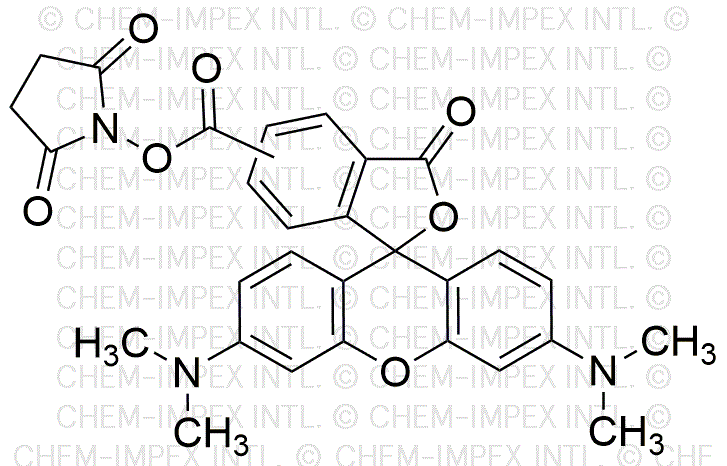5(6)-Carboxytetramethylrhodamine N-succinimidyl ester is widely utilized in research focused on:
- Fluorescent Labeling: This compound is commonly used to label proteins and antibodies in biological research, allowing scientists to visualize and track cellular processes under a fluorescence microscope.
- Cell Imaging: It plays a crucial role in live-cell imaging applications, enabling researchers to monitor dynamic biological events in real-time, which is essential for understanding cellular behavior and interactions.
- Flow Cytometry: The compound is employed in flow cytometry for the analysis of cell populations. Its fluorescent properties help distinguish between different cell types, aiding in immunology and cancer research.
- Drug Delivery Systems: It can be integrated into drug delivery systems, where its fluorescent characteristics help in tracking the distribution and release of therapeutic agents within biological systems.
- Diagnostic Applications: This chemical is utilized in the development of diagnostic assays, particularly in detecting specific biomolecules, enhancing the sensitivity and specificity of tests in clinical settings.
General Information
Properties
Safety and Regulations
Applications
5(6)-Carboxytetramethylrhodamine N-succinimidyl ester is widely utilized in research focused on:
- Fluorescent Labeling: This compound is commonly used to label proteins and antibodies in biological research, allowing scientists to visualize and track cellular processes under a fluorescence microscope.
- Cell Imaging: It plays a crucial role in live-cell imaging applications, enabling researchers to monitor dynamic biological events in real-time, which is essential for understanding cellular behavior and interactions.
- Flow Cytometry: The compound is employed in flow cytometry for the analysis of cell populations. Its fluorescent properties help distinguish between different cell types, aiding in immunology and cancer research.
- Drug Delivery Systems: It can be integrated into drug delivery systems, where its fluorescent characteristics help in tracking the distribution and release of therapeutic agents within biological systems.
- Diagnostic Applications: This chemical is utilized in the development of diagnostic assays, particularly in detecting specific biomolecules, enhancing the sensitivity and specificity of tests in clinical settings.
Documents
Safety Data Sheets (SDS)
The SDS provides comprehensive safety information on handling, storage, and disposal of the product.
Product Specification (PS)
The PS provides a comprehensive breakdown of the product’s properties, including chemical composition, physical state, purity, and storage requirements. It also details acceptable quality ranges and the product's intended applications.
Certificates of Analysis (COA)
Search for Certificates of Analysis (COA) by entering the products Lot Number. Lot and Batch Numbers can be found on a product’s label following the words ‘Lot’ or ‘Batch’.
*Catalog Number
*Lot Number
Certificates Of Origin (COO)
This COO confirms the country where the product was manufactured, and also details the materials and components used in it and whether it is derived from natural, synthetic, or other specific sources. This certificate may be required for customs, trade, and regulatory compliance.
*Catalog Number
*Lot Number
Safety Data Sheets (SDS)
The SDS provides comprehensive safety information on handling, storage, and disposal of the product.
DownloadProduct Specification (PS)
The PS provides a comprehensive breakdown of the product’s properties, including chemical composition, physical state, purity, and storage requirements. It also details acceptable quality ranges and the product's intended applications.
DownloadCertificates of Analysis (COA)
Search for Certificates of Analysis (COA) by entering the products Lot Number. Lot and Batch Numbers can be found on a product’s label following the words ‘Lot’ or ‘Batch’.
*Catalog Number
*Lot Number
Certificates Of Origin (COO)
This COO confirms the country where the product was manufactured, and also details the materials and components used in it and whether it is derived from natural, synthetic, or other specific sources. This certificate may be required for customs, trade, and regulatory compliance.


